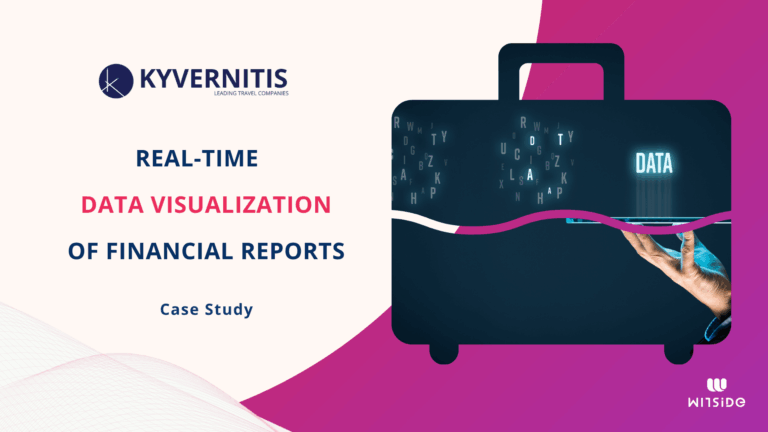Why Data Management Matters
Data is power — but only when it’s managed right.
Scattered, inconsistent, or outdated data slows decisions, creates silos, and leads to missed opportunities.
Smart data management, like we do it at WITSIDE, brings order to the chaos, ensuring accuracy, security, and instant accessibility. It’s the key to real-time insights, AI-driven analytics, and smarter decision-making.
Our Data Management Services
Data Governance
We create clear policies and frameworks to protect data integrity, ensure compliance, and uphold ethical standards.
Data Security & Privacy
We protect sensitive information with advanced encryption, access controls, and GDPR-aligned privacy measures.
Data Catalogs
We create structured, searchable inventories of your data assets, facilitating discovery and ensuring consistency across your teams.
Master Data Management (MDM)
We unify and standardize data across systems to ensure accuracy and a single source of truth that boosts your operations.
Data Warehousing
We build scalable data warehouses to store and retrieve structured data efficiently.
Data Architecture
We create a robust framework that ensures seamless data flow, optimal performance, and scalability, aligning your data infrastructure with your business goals.
ETL (Extract, Transform, Load)
We automate data extraction, transformation and loading for accuracy and speed.
Data Quality Management
We ensure your data is accurate, reliable, and ready for analysis by eliminating inconsistencies and redundancies.
Real-Time Data Processing
We enable real-time monitoring and analysis to help you make faster, more informed decisions.
Cloud Data Management
We help optimize your data in cloud environments for flexibility, scalability, and cost efficiency.
Data Migration
We safely transfer data across systems with minimal downtime and maximum reliability.
Big Data Management
We handle large, complex datasets with advanced tools and techniques for actionable insights.
Data Strategy Development
We create tailored, comprehensive strategies to align data initiatives with your business objectives, ensuring long-term value and measurable results.
Advanced Analytics Enablement
Leverage AI and machine learning with expert guidance to uncover patterns, predict trends, and translate raw data into strategic insights.
Data Compliance
We help you establish policies and standards to ensure data integrity, security, and regulatory compliance, building trust across your organization.
Training and Support
We equip your teams with the skills and knowledge needed to maximize the value of data-driven tools, ensuring seamless adoption and effective usage.
Unlock the Full Potential of Your Data with WITSIDE
Go beyond managing data. Master it.
Eliminate Data Silos
Break down barriers between systems to create a unified, centralized view of your data for smarter and faster decision-making.
Boost Accuracy & Reliability
Ensure your data is clean, reliable, complete, and up to date, empowering teams to act confidently and take high-impact decisions.
Streamline Operations
Automate manual tasks, reduce time spent chasing information, and improve efficiency by organizing and integrating data across your organization.
Guard Security & Compliance
Protect sensitive information with robust governance frameworks and compliance measures, reducing the risk of breaches or penalties.
Fuel AI & Analytics
Provide a solid, scalable data foundation to power predictive models and intelligent automation.
Maximize Business Impact
Turn raw data into actionable insights that uncover new value and opportunities, and drive measurable results.
Case Studies
See how we’ve helped companies in Greece and abroad achieve digital transformation across leading industries, including energy, oil & gas, retail, and tourism.
- BI, Data Management
- Advanced Analytics
- BI, Data Management
Want to learn more?
Tools & Technologies We Use
We leverage the best data analytics tools to predict the future and drive business success.
Qlik Data Integration Platform consolidates data from multiple sources into a complete, accurate, and up-to-date dataset for BI, analysis, and business processes.

Azure Cloud is a cloud computing platform that offers scalable solutions for data storage, integration, and advanced analytics with enterprise-grade security.

Microsoft Fabric integrates data engineering, warehousing and real-time analytics within Microsoft’s Power BI and Azure ecosystem, offering scalability, security and efficiency.
Databricks is a unified platform for big data and AI, enabling enabling seamless collaboration and highly scalable, real-time data processing across the entire data lifecycle.

Talend streamlines ETL, governance and cloud connectivity, enabling businesses to transform and manage data seamlessly across hybrid and multi-cloud environments.
Open Source
Open Source is a flexible, community-driven approach to data integration and analytics, offering transparency, adaptability, cost-efficiency, and the freedom to innovate.
What Our Clients Say



FAQs
What is data management, and why is it important for my business?
Data management involves collecting, storing, organizing, and maintaining data securely and efficiently throughout its lifecycle.
It transforms raw data into valuable insights by ensuring it is accurate, accessible, and ready for analysis, enabling better decision-making and strategic planning.
Effective data management ensures your business stays competitive, efficient, and ready to seize new opportunities.
Why it matters:
🚀 Improves Decision-Making: Reliable data empowers informed and strategic decisions.
🚀 Boosts Efficiency: Streamlined processes save valuable time.
🚀 Ensures Security and Compliance: Protect sensitive information while meeting regulatory standards.
🚀 Supports Growth: Scalable systems adapt as your data needs expand.
What industries can benefit from data management solutions?
Our data management solutions are designed to benefit a wide range of industries that rely on data to drive operations, make strategic decisions, and maintain competitiveness. Key industries that can greatly benefit include:
🚀 Energy, Oil & Gas: Efficient data management is critical for optimizing energy production, tracking resources, and ensuring compliance with environmental regulations.
🚀 Retail: Our solutions help retailers gain insights into customer behavior, optimize inventory, and drive personalized marketing efforts.
🚀 Financial Services: We assist financial institutions in managing vast amounts of sensitive financial data, improving risk analysis, and ensuring regulatory compliance.
🚀 Healthcare: Proper data management helps enhance patient care, medical research, and secure handling of patient records.
How secure are your data management services?
Security is at the core of our data management solutions. We implement robust, industry-standard security measures to protect your data throughout its entire lifecycle—from collection and storage to processing and distribution. Our approach ensures that your sensitive information is safeguarded against threats, while also ensuring compliance with relevant regulations.
Key aspects of our security framework include:
🚀 Data Encryption: We use advanced encryption protocols to protect data both at rest and in transit, preventing unauthorized access.
🚀 Access Controls: We implement strict user authentication and role-based access controls to ensure only authorized personnel can access specific data sets.
🚀 Compliance and Regulatory Alignment: Our solutions are designed to comply with industry regulations, such as GDPR, HIPAA, and other regional standards, ensuring your business meets all legal requirements.
🚀 Regular Audits and Monitoring: We continuously monitor and audit our systems for vulnerabilities, keeping your data safe from emerging cyber threats.
Can data management scale as my business grows?
Absolutely. WITSIDE’s data management services are designed with scalability in mind, ensuring that your data infrastructure grows seamlessly alongside your business.
Whether you are a growing organization or a large enterprise expanding into new markets, our solutions adapt to your evolving needs without compromising performance or efficiency.
🚀 Flexible Infrastructure: Our systems are built to accommodate increasing volumes of data, allowing you to add new data sources, users, and applications as your business expands.
🚀 Modular Design: Our data management architecture is modular, meaning you can scale up specific components, such as storage or processing power, based on your unique requirements.
🚀 Cloud and Hybrid Solutions: We offer cloud-based and hybrid data management options, enabling easy scalability and flexibility as your organization’s needs change.
What role does data architecture play in data management?
Data architecture serves as the foundation of effective data management, providing the blueprint for how data is collected, stored, processed, and accessed across an organization. It defines the rules, policies, and standards that govern the flow of data, ensuring consistency, accuracy, and security throughout its lifecycle.
Key roles of Data Architecture in Data Management include:
🚀 Structuring Data Flow: Data architecture creates a formalized framework that dictates how data moves between systems, departments, and applications. This ensures seamless data integration and reduces silos within the organization.
🚀 Optimizing Data Storage and Access: It determines how and where data is stored — whether on-premises, in the cloud, or in a hybrid environment — ensuring data is accessible when needed while optimizing storage efficiency.
🚀 Ensuring Data Consistency and Integrity: By enforcing data standards and validation rules, data architecture ensures that the data remains accurate, consistent, and trustworthy across different systems and applications.
🚀 Supporting Scalability and Flexibility: A well-designed data architecture allows your business to scale efficiently, accommodating growth and changing requirements without disrupting operations.
What are the challenges of financial data management?
Managing financial data comes with unique challenges. Luckily, our expert team can help tackle these issues effectively, empowering your organization with secure, compliant, and actionable financial data.
🚀 Data Accuracy: Inaccurate financial data can lead to errors in reporting, poor decisions, and compliance risks. We ensure data is complete, reliable, and error-free.
🚀 Compliance: Adhering to strict standards like GAAP, IFRS, and SOX is critical, but constantly evolving regulations make compliance complex.
🚀 Security: Financial data is highly sensitive and a prime target for cyberattacks. Balancing strong protection with accessibility is essential.
🚀 Integration: Combining data from multiple sources like ERP systems and spreadsheets into one unified system is resource-intensive but necessary for accurate analysis.
🚀 Scalability: Growing data volumes and complexity strain systems, requiring scalable solutions to maintain performance and consistency.
🚀 Real-Time Access: Providing accurate, up-to-date financial information for timely decision-making can be challenging in large or complex systems.
Business Intelligence
Transform complex data into intuitive, interactive dashboards that empower decision-makers to
uncover actionable insights and drive business success with clarity and precision.
Advanced Analytics
Leverage cutting-edge Advanced Analytics techniques to predict trends, optimize operations, and enable data-driven innovation that propels your business into the future.




